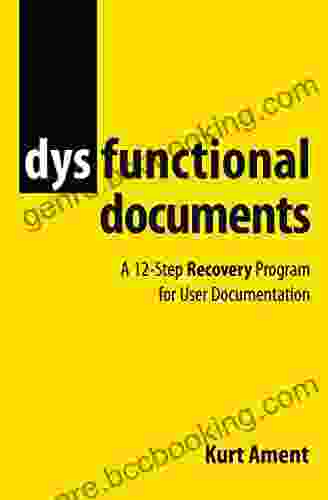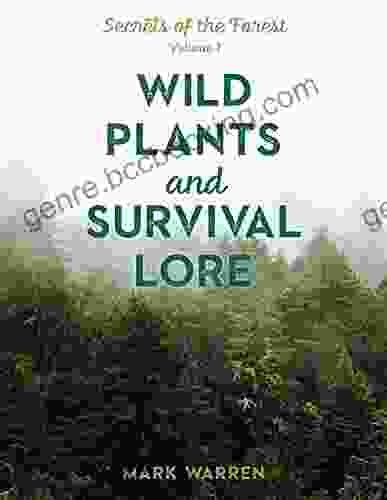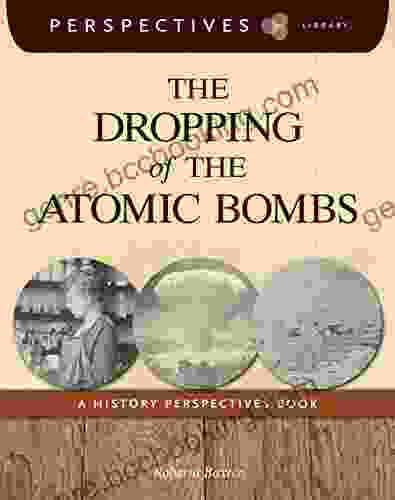12-Step Recovery Program for User Documentation: The Ultimate Guide to Writing Clear, Concise, and Effective Docs

4.2 out of 5
| Language | : | English |
| File size | : | 2317 KB |
| Text-to-Speech | : | Enabled |
| Screen Reader | : | Supported |
| Enhanced typesetting | : | Enabled |
| Print length | : | 87 pages |
| Lending | : | Enabled |
Are you struggling to write user documentation that's clear, concise, and effective? If so, you're not alone. User documentation is often one of the most challenging types of writing to do well. But it's also one of the most important. After all, your users need to be able to understand your documentation in Free Download to use your product successfully.
This 12-step recovery program will help you get your user documentation in shape. We'll cover everything from planning and organizing your documentation to writing clear and concise prose. By the end of this program, you'll be writing user documentation that's a pleasure to read and use.
Step 1: Define Your Audience
The first step to writing effective user documentation is to define your audience. Who are you writing for? What are their needs and expectations? Once you know who you're writing for, you can tailor your documentation to meet their specific needs.
To define your audience, ask yourself the following questions:
- Who are the primary users of your product?
- What are their technical skills and knowledge level?
- What are their goals and objectives?
- What are their pain points?
Once you have a good understanding of your audience, you can start to develop a user profile. This profile will help you keep your audience in mind as you write your documentation.
Step 2: Plan and Organize Your Documentation
Once you know who you're writing for, you can start to plan and organize your documentation. This step is important because it will help you create a logical and easy-to-follow document.
To plan and organize your documentation, follow these steps:
- Identify the main topics that you need to cover.
- Create an outline that shows the hierarchy of your topics.
- Write a table of contents that lists the main topics and their corresponding page numbers.
By following these steps, you can create a well-organized document that's easy for users to navigate.
Step 3: Write Clear and Concise Prose
Once you have your documentation planned and organized, you can start writing. The key to writing clear and concise prose is to use simple language and to avoid jargon. You should also use active voice and present tense whenever possible.
Here are some tips for writing clear and concise prose:
- Use simple language. Avoid using technical jargon or slang.
- Avoid jargon. If you must use jargon, define it the first time you use it.
- Use active voice. Active voice is more direct and easier to understand than passive voice.
- Use present tense. Present tense is more immediate and engaging than past tense.
By following these tips, you can write user documentation that's clear, concise, and easy to understand.
Step 4: Use Visuals to Enhance Understanding
Visuals can help to make your documentation more engaging and easier to understand. Use visuals such as screenshots, diagrams, and charts to illustrate your points.
Here are some tips for using visuals effectively:
- Use visuals to illustrate your points. Don't just use visuals for decoration.
- Make sure your visuals are clear and easy to understand. Avoid using cluttered or confusing visuals.
- Use visuals consistently throughout your documentation. This will help to create a統一的visual experience.
By following these tips, you can use visuals to enhance the understanding of your user documentation.
Step 5: Test Your Documentation
Once you have written your documentation, it's important to test it with users. This will help you to identify any areas that need improvement.
To test your documentation, follow these steps:
- Recruit a group of users to test your documentation.
- Give them a set of tasks to complete using your documentation.
- Observe how they interact with your documentation.
- Ask them for feedback on your documentation.
By following these steps, you can test your documentation and identify any areas that need improvement.
Step 6: Revise and Edit Your Documentation
Once you have tested your documentation, it's time to revise and edit it. This step is important because it will help you to improve the clarity, accuracy, and consistency of your documentation.
To revise and edit your documentation, follow these steps:
- Review your documentation carefully. Look for any errors in grammar, spelling, or punctuation.
- Make sure your documentation is consistent. Use the same style and tone throughout your documentation.
- Ask a colleague to review your documentation. A fresh pair of eyes can help you to identify any areas that need improvement.
By following these steps, you can revise and edit your documentation to improve its clarity, accuracy, and consistency.
Step 7: Maintain Your Documentation
Once you have published your documentation, it's important to maintain it. This means updating your documentation as your product changes. It also means responding to user feedback and making revisions as needed.
To maintain your documentation, follow these steps:
- Set up a system for tracking changes to your product.
- Update your documentation regularly as your product changes.
- Respond to user feedback and make revisions as needed.
By following these steps, you can maintain your documentation and ensure that it remains accurate and up-to-date.
Step 8: Promote Your Documentation
Once you have created and maintained your documentation, it's important to promote it. This means making your documentation available to users and encouraging them to use it.
To promote your documentation, follow these steps:
- Make your documentation available online.
- Promote your documentation on social media.
- Write blog posts about your documentation.
- Give presentations about your documentation.
By following these steps, you can promote your documentation and encourage users to use it.
Step 9: Get Feedback from Users
Once you have promoted your documentation, it's important to get feedback from users. This will help you to identify any areas that need improvement.
To get feedback from users, follow these steps:
- Ask users for feedback on your documentation.
- Use surveys to collect feedback from users.
- Monitor social media for feedback on your documentation.
By following these steps, you can get feedback from users and identify any areas that need improvement.
Step 10: Continuously Improve Your Documentation
User documentation is a living document. It should be constantly updated and improved to reflect the changing needs of your users. By following the steps
4.2 out of 5
| Language | : | English |
| File size | : | 2317 KB |
| Text-to-Speech | : | Enabled |
| Screen Reader | : | Supported |
| Enhanced typesetting | : | Enabled |
| Print length | : | 87 pages |
| Lending | : | Enabled |
Do you want to contribute by writing guest posts on this blog?
Please contact us and send us a resume of previous articles that you have written.
 Book
Book Novel
Novel Page
Page Chapter
Chapter Text
Text Story
Story Genre
Genre Reader
Reader Library
Library Paperback
Paperback E-book
E-book Magazine
Magazine Newspaper
Newspaper Paragraph
Paragraph Sentence
Sentence Bookmark
Bookmark Shelf
Shelf Glossary
Glossary Bibliography
Bibliography Foreword
Foreword Preface
Preface Synopsis
Synopsis Annotation
Annotation Footnote
Footnote Manuscript
Manuscript Scroll
Scroll Codex
Codex Tome
Tome Bestseller
Bestseller Classics
Classics Library card
Library card Narrative
Narrative Biography
Biography Autobiography
Autobiography Memoir
Memoir Reference
Reference Encyclopedia
Encyclopedia Leonard A Batterson
Leonard A Batterson Peter Manseau
Peter Manseau Lari Hilzinger
Lari Hilzinger Linda Elsegood
Linda Elsegood Laura Klein
Laura Klein Lester Meachem
Lester Meachem Lady Gaga
Lady Gaga Latoya Hunter
Latoya Hunter Latonya J Trotter
Latonya J Trotter Richard Headstrom
Richard Headstrom Lama Zopa Rinpoche
Lama Zopa Rinpoche Laurie Gwen Shapiro
Laurie Gwen Shapiro Laureen Jordan
Laureen Jordan Mike Zimmerman
Mike Zimmerman Lillian Tibbles Phd
Lillian Tibbles Phd Linda Gray
Linda Gray Vanda Jackson
Vanda Jackson Laura Mckowen
Laura Mckowen Lyanda Lynn Haupt
Lyanda Lynn Haupt Uncle Bob
Uncle Bob
Light bulbAdvertise smarter! Our strategic ad space ensures maximum exposure. Reserve your spot today!
 Luke BlairFollow ·19.3k
Luke BlairFollow ·19.3k Thomas HardyFollow ·18.6k
Thomas HardyFollow ·18.6k Bobby HowardFollow ·10.6k
Bobby HowardFollow ·10.6k Gerald ParkerFollow ·19.6k
Gerald ParkerFollow ·19.6k Alex ReedFollow ·18.5k
Alex ReedFollow ·18.5k Charles ReedFollow ·16.4k
Charles ReedFollow ·16.4k Phil FosterFollow ·11.1k
Phil FosterFollow ·11.1k Jonathan FranzenFollow ·7.9k
Jonathan FranzenFollow ·7.9k

 Branden Simmons
Branden SimmonsUnveiling the World of Tequila: A Collector's Guide to...
: Prepare to embark on a tantalizing journey...
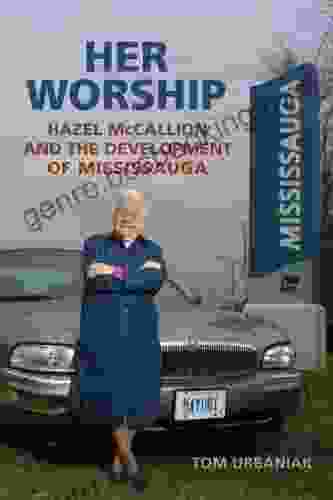
 Chuck Mitchell
Chuck MitchellHazel McCallion and the Development of Mississauga: A...
: The Matriarch of Mississauga Hazel...

 Lucas Reed
Lucas ReedUnveiling the Hidden Treasures of Tequila, Mezcal, and...
Prepare to be captivated...
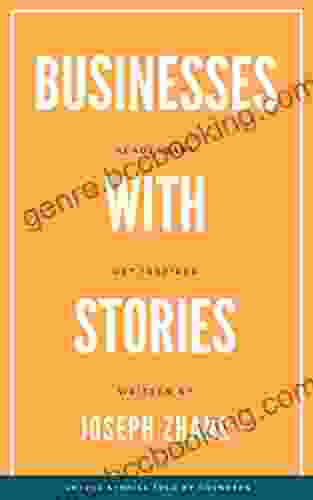
 Isaias Blair
Isaias BlairBusinesses With Stories: The Power of Storytelling in...
In today's competitive business environment,...

 Ethan Gray
Ethan GrayUnveiling the World of Tequila, Mezcal, and Sotol: The...
Embark on a...
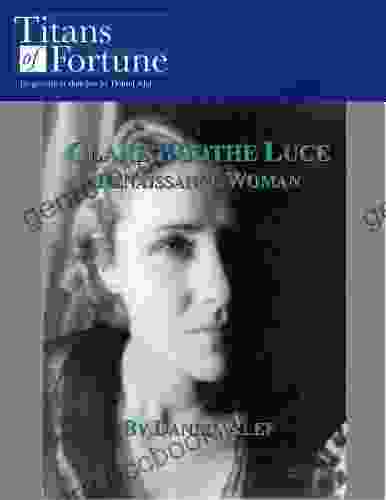
 Barry Bryant
Barry BryantClare Boothe Luce: Renaissance Woman
In the annals of history, few...
4.2 out of 5
| Language | : | English |
| File size | : | 2317 KB |
| Text-to-Speech | : | Enabled |
| Screen Reader | : | Supported |
| Enhanced typesetting | : | Enabled |
| Print length | : | 87 pages |
| Lending | : | Enabled |


